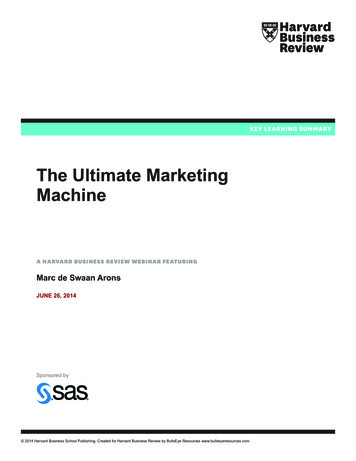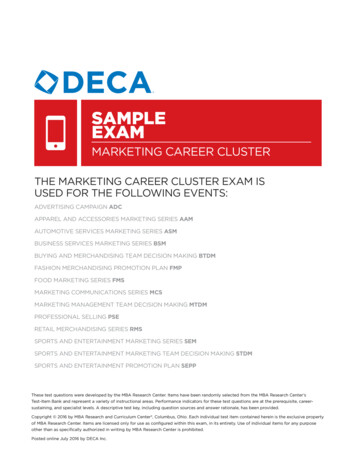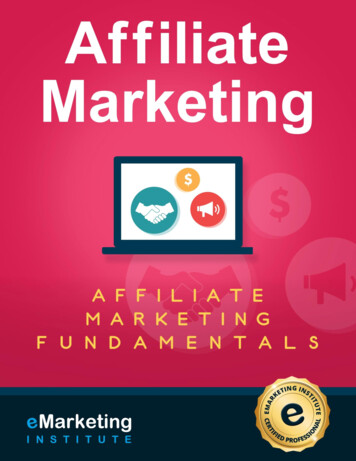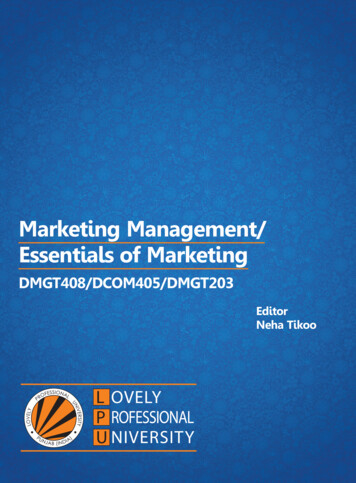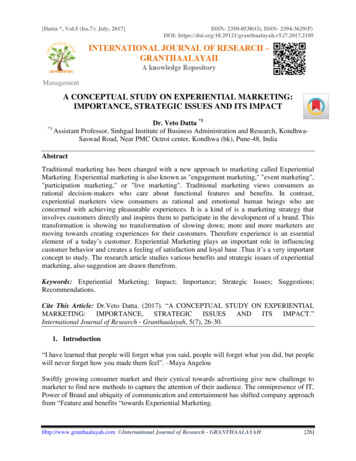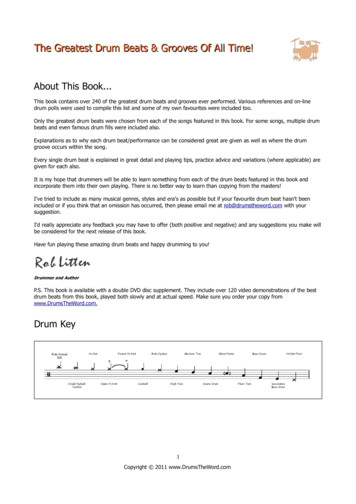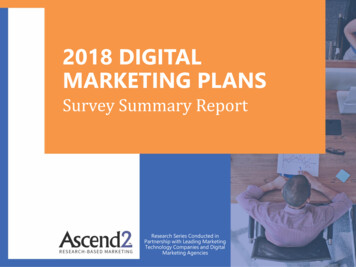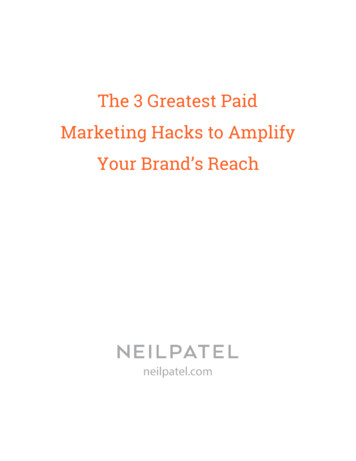
Transcription
The 3 Greatest PaidMarketing Hacks to AmplifyYour Brand’s Reach
Here are 3 effective strategies to shorten your paid advertising learning curve.1. Improve your ad’s relevance and lower your campaign costs byimproving your quality scoreLet us show you ways to improve your score on three platforms – Google, Twitter and Facebook.1. Google AdWords When launching paid search campaigns on AdWords, you get a quality score thatdetermines how much you pay for a click. It’s Google’s way of telling you if you’re satisfying your customer needs. Along with your maximum bid, this score also determines your ad rank in auctions. How is the score determined? No one knows the exact ratio of factors in the algorithm. But,here are 4 major factors that impact the quality score. Past performance of your AdWords account Relevance of your used keywords with the ad group they are in Ad copy relevance and click through rate (CTR) of your ad The quality and relevance of your landing pages A higher quality score will not just lower your Cost per click (CPC), but will also increase yourconversions.Note: The quality score that you see (a whole number between 1 and 10) isn’t the one usedby Google to determine your CPC. Instead, Google uses a real number on a non-linear scale(along with a bunch of other factors) to determine your CPC. How can you improve your quality score? Here are 3 strategies.i. Good Keyword Research and Tight Organization – It’s all about user intent. Keep digging andadding highly relevant keywords to your campaign. Obviously, long-tail keywords are good additions because of their specificity and typicalposition towards the end of the purchasing funnel. WordStream found that prominence of long-tail keywords in a successful AdWords account(with quality score of 8.8) was a major factor that led to a higher quality score. Additionally. Organizing your account into tighter themed ad groups will help in creatingmore effective ads.
Pro Tip: Do you want to prevent wasting your budget before anything happens? Then,continuously research, identify and include negative keywords in your campaign so thatyour ad does not show up for irrelevant search queries. Although these keywords might not impact your quality score directly, you’ll reduce yourirrelevant impressions. That, in turn, will improve your CTR and therefore increase yourquality score. You can use WordStream’s free negative keyword research tool for mining irrelevantkeywords in your campaign.ii. Improve your CTR – The number of clicks on your ad (CTR) is the most crucial factor indetermining your quality score. One way of improving your CTR and increasing your account’s average quality score is byincreasing your budget for branded keywords. Larry Kim from WordStream recommends setting aside at least 15% of your spend forbranded keywords. Since your website will also rank for branded keywords, bidding on your brand keywordswill earn the most real estate above-the-fold. Another hack to improve your CTR is using site extensions like sitelinks, call/locationextensions, app download CTA or product listing ads like the ones below. Finally, you need to consistently keep optimizing your ad copy to keep it more relevant andtargeted. Campaigns run stale quickly and your ROI from them will keep declining.iii. Optimize your landing pages – You need to keep your ad copy relevant to the content on yourlanding page. Not doing that is the number one mistake that hampers conversions. Watch this video tutorial by Google discussing the basics of website design to help you getbetter results. You can check your quality score by logging into your AdWords account. Navigate tocampaigns. Then, choose the keywords tab and click on the white speech bubble next to thekeyword’s status. You can also use WordStream’s free performance grader tool to check the quality of yourad. It’ll do a quick audit of your account across 8 key performance metrics. You just need to logon to www.wordstream.com/google-adwords, enter your email addressand click on the blue ‘Get your Grade’ button to get started. You’ll get a plotting of your average quality score in the last 90 days.
Along with the number of impressions happening at each quality score, you’ll also see agraph of the industry benchmark.2. Facebook Ads Similar to Google, Facebook gives you a relevance score for your ads. It’s Facebook’s way ofevaluating whether or not your business advertisement is showing to the people who careabout it. Are you wondering what factors might influence your relevance score on Facebook? Thestory is similar to Google AdWords. A higher CTR on your ad means it’s targeting the right people. More shares on your ad is a strong signal of its quality and hence improves your score.Even the likes and comments of your ad might be considered. Be wary of a user hiding your ad from their newsfeed. It’s a strong negative endorsementof targeting. So, how do you improve your relevance score and increase the effectiveness of yourcampaign? Here are 3 strategies.i. Split test images – Testing images can make all the difference. Plain images sometimes workbetter than dazzling ones.ii. Check your Ad frequency – Did you know you that banner blindness has even infiltrated theFacebook Newsfeed? That’s because a whooping 1,500 stories are vying for a user’s attention whenhe logs in.iii. Set laser-focused targeting – It can make all the difference in the world. Facebook gives you awealth of targeting options (almost 1500 data points per user). Try to narrow down who’s seeingyour ad to the most relevant group of customers possible. You can even create a custom audience from your email lists and tremendously improveyour relevance score.3. Twitter Ads Twitter uses quality adjusted bids to determine the ads it will display. This score is comprised mostly by the 3R’s – Resonance, Relevance and Recency (other thanyour bid amount). If your engagement rate increases to 60%: The cost per engagement becomes one penny.And, at 36% engagement, it’s two pennies. Do you want to improve your quality score on Twitter? Here are 2 strategies.
i. Promote only your best tweets – Find your high engagement tweets by exporting data from theTwitter Analytics dashboard and allocate them maximum budget for amplification.ii. Narrow your targeting – If the CTA on your landing page is the call button or if it’s relevant tolocal customers, then you should only target mobile visitors, because it’s relevant to local peopleon the go. You can also use partner audiences by Twitter to reach people based on their offlineactivity. They’re available under “Select Behaviors.” You get a chance to choose from a variety of 1000 audiences across 12 broad categories.Choose precisely. If you want more strategies, you can check out my detailed article on how to improve yourTwitter Quality score .2. Launch remarketing campaigns by segmenting your websitevisitors or by creating a custom/tailored audience 70% of shoppers abandon their cart. In fact, 49% of individuals visit a website 2-4 timesbefore they make a purchase. It doesn’t mean that a prospect didn’t like your brand or your offerings. They might havejust gotten distracted. And, if you act fast, you can still close the sale. Through a remarketing campaign. It’s also agreat way to improve your brand recall. Google Display Network is a prime remarketing ground as well, as it reaches 92% of allinternet users in the US. Social media platforms like Facebook and Twitter also have robust remarketing ad tools. The best part about these ads isn’t their lower cost or higher click through rate (CTR) overtraditional ads. Now that you’ve got a high-level view of their effectiveness, here is how you should setup aremarketing campaign on Google.How to create a remarketing list inside Google? In Google’s ad ecosystem, you can create a list of your abandoned website visitors bytagging them with a cookie when they visit a specific page on your website. Step #1 – Find your remarketing tag by logging into Google AdWords, then navigate to: Shared library Set up remarketing.
Copy and paste the tag into the footer of your website. You may want to hire a developerand email it to him for help with implementation. Log back into your AdWords account and check if your remarketing tag has activated. Step #2 – Navigate to Audiences Remarketing List. Enter a name for your remarketing list. Then, let’s tackle the other elements one-by-one. Your remarketing list should target specific users that abandoned your conversion pathmidway, like those who abandoned a product page on your website. Choose who to add to your list based on your remarketing campaign objectives. If you’ve analytics data includes accounting for high financial value of a section of yourwebsite visitors, then you should bid aggressively for that section. Inside the rule field, you need to setup the type of visitors you want to target. Enter the exact URLs of the pages your target customers came to for the list previouslyvisited and the page that they didn’t move onto. Your list will need at least 100 visitors to your website within the last 30 days to qualify for aremarketing campaign. Step #3 – Choose the duration of your ads (the number of days you want your ad to follow auser). It’s called the audience membership duration. This number will vary based on the sales cycle of the product/service you’re advertising. You’ll need to test this number to find the sweet spot for your audience (Larry Kimrecommends you to set it to 3x your average sales cycle length). Step #4 – Once you’ve created the list, you can start your AdWords campaign by headingover to Campaign from the All Campaigns in AdWords. Choose “Display Network only”. Step #5 – You should also set your frequency capping. Don’t be afraid of testing a highnumber of impressions. As you deliver targeted messages, add value and keep rotating your ads, your users won’tget creeped out. There are 14 ad formats that you can use on the Google Display network. This gives you getthe chance to experiment rigorously. On Facebook, you can create a custom audience from Ads Manager. You can even targetyour email subscribers. Check out this article on Facebook Advertisements for detailedinstructions.
On Twitter, you can use tailored audiences for running a remarketing campaign. Refer tothis article at Quick Sprout for detailed instructions.3. Ditch the prominent advertising networks. Maybe you can gain aterrific ROI from smaller niche networks Start by having a look at the demographic data of upcoming social networks. Maybe you’ve got a majority of your target audience hanging out on a smaller network. This article by Sprout Social might help you to get started with demographic informationabout social networks. Keep an eye on how your competitors are carrying out their marketing campaigns. Maybe they’re finding great ROI from Bing advertising. If this is the case, it might be worth ashot for you as well. Here are 2 tools to help you spy.i. BuzzSumo – Key your competitor’s website into the search box and click on the go button. You’ll see the articles with most share on Facebook and other popular social networkchannels, like Twitter, Pinterest. You next need to drill into their social media presence on these smaller networks and see ifthey’re doing any paid marketing campaigns. You can even find out the influencers who’ve shared and contributed to the success of themost popular content of your competitors. Just click on the view sharers button. If you find models (or celebrities with massive following) who aren’t related to your nichesharing your competitor’s content, then they might be getting paid to do that publicity. This is an unconventional paid marketing model that you can also consider.ii. Rival IQ – This is a great paid intelligence tool that can help you to dive deep into yourcompetitor’s marketing strategy. You can directly add your competitors to your landscape and start analyzing competitorprofiles on all major social networks. You’ll get detailed insights on the audience size, posting frequency and engagement of yourcompetitors on social media.
Keep close tabs and, if you notice a huge increase in weekly engagement, it’s a sign of paidadvertising on the network. Next, here are 3 specific case studies to demonstrate the value smaller networks can deliverfor your brand.1. How a retailer generated 41,254.34 in revenue from 775.50 in ad spend from PinterestAdvertising – Ezra used promoted pins to send people to a story about his brand and the productson his website. And people clicked through to buy stuff from his eCommerce store. He spent a total of 775.50 dollars on advertising that produced 17 cent clicks. And, howmuch revenue did he generate? It was a staggering 21,969. He even points out that his other revenue sources have doubledbecause of Pinterest.2. How HP generated over 2,000 brand advocates using LinkedIn Recommendation Ads – Doyou know that LinkedIn generates almost 3x ROI for B2B business as compared to Facebook orTwitter? You can either promote a company update or create direct sponsored content. You’ll get a bunch of targeting options including company, job title, field of study, skills,school and more. Let’s look at HP’s case study. The aim of launching their LinkedIn campaign was targetingsmall business owners and gaining their trust. They used LinkedIn recommended Ads toaccelerate their results. You can watch a video breakdown of this c ase study here. 3. How a retailer achieved 800% ROI by repurposing and promoting content using Outbrain –Turning to a paid discovery network like Outbrain can be really helpful in some niches, such as thecase of this department store. They repurposed their content using existing digital assets and shopping guides in 7merchandise categories. Then, they turned to Outbrain for amplification in the Outbrain network. A majority of conversions from distributing the shopping guides surfaced after 7 days. And, the estimated revenue? It’s 3.5 million.
Watch this video tutorial by Google discussing the basics of website design to help you get better results. You can check your quality score by logging into your AdWords account. Navigate to campaigns. Then, choose the keywords tab and click




